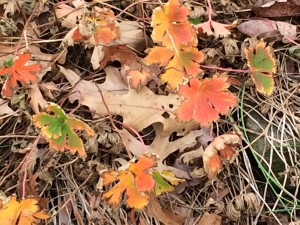This has been the warmest December I can remember. Until today, I have been too sick to enjoy it but today I wandered through my gardens and there were so many treasures.
One of the first, in three different delineations, was the unusual perennial Arum italicum that I love for its unusual life cycle. Unlike most herbaceous plants, Arum italicum foliates in early fall and the arrow-shaped leaves are quite visible during the winter (unless covered by snow) and spring. In May, a creamy-yellow spadix cupped by a spathe of green, quite similar to that of Arisaema triphyllum (Jack-in-the-Pulpit), appears. After flowering, the leaves disappear, leaving only the flowering stalk which is relatively inconspicuous. Never deadhead the spadix or you will miss the show. Gradually, the stalk develops large green berries. Then, suddenly, in late July and early August, there is an orange-red, large berried “stick”. Normally, the berries last well into the fall but some animals seem to enjoy them too, much to my dismay.
I acquired my first one, the cultivar ‘Pictum’, in 1997 from Holden Arboretum. The leaves have prominent white veins and are so beautiful right now. The tubers spread so I now have a sizable clump. That year, I also purchased the cultivar ‘Special Leaf’ from Montrose Nursery, sadly no longer in existence. It is similar in variegation to ‘Pictum’ but the ends of many of the leaves are rounded rather than pointed. My third cultivar is Arum italicum ssp.neglectum ‘Chameleon’ and its leaves are wider and rounder than those of the other two. It grows in a much drier spot and thus the clump has not enlarged as much.
One of the first combinations I noticed was the bright green of Heuchera ‘Brownies’ as it contrasted with the bronzy, windswept foliage of Miscanthus purpurascens and the dark tracery of the vine Schizophragma corylieum in the background.
During the winter, epimedium leaves usually acquire a dark edge or turn beige but during our unusual weather, some of the leaves are either orange or ruby red. Many Heuchera leaves change color through the year. Heuchera ‘Color Beauty’ has changed from green with maroon veins to coppery maroon.
I also noticed that many of the hardy geraniums have morphed from green to yellow or orange this year. Usually they acquire a maroon tinge.
This year, I had a number of leftover seedlings of purple flowering cabbage and they have done exactly what I had hoped they would. I now have sprinklings of bright purple throughout the garden.
One of the many attributes of Carex ‘Everillo’ is its chartreuse color in the shade. Now that the trees have lost their leaves, the color is a bit more yellow and quite striking. This Carex is sited at the front and left end of my left garage bed. Also in that bed, but in back and on the right, is Thujopsis dolobrata ‘Aurea’, a yellow conifer with wonderful texture. The two yellows make an electrifying and happy combination for gray days.
The first of my hellebores to bloom each year is Helleborus niger ‘Josef Lemper’. In 2011, we also had a mild December, and like today, this hellebore was in bud. What I never expected to see was some blossoms of Clematis ‘Venosa Violacea’, a fall bloomer that obviously decided to bloom some more nor new blooms of Kniphofia ‘Pineapple Popsicle’. I love these reblooming poker plants.
Even my everblooming Rosa Oso Easy ‘Cherry Pie’ has joined the show, displaying its yellow foliage, orange hips, and a few cherry flowers. Snapdragons have an amazing capacity endure almost any kind of weather and soil conditions. I even some still reblooming in a crack on the front porch.
I hope that you have been having similar experiences.















0 Comments